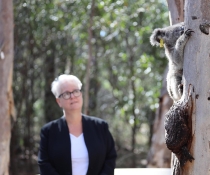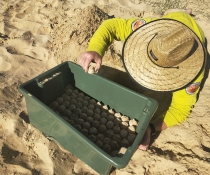Excitement as 8 more Eastern bristlebirds join the wild ones
To help protect one of Australia's rarest birds, 8 captive-bred eastern bristlebirds were released into the wild to join the critically endangered northern population this year.

This brings the number of captive-bred birds released in the past year to 24.
Eastern bristlebirds were once a common sight in southeast Queensland, eastern New South Wales (NSW), and Victoria, but numbers have plummeted to less than 2500 in the wild.
The northern population remains very small, estimated at fewer than 50 individuals living in isolated pockets across the Border Ranges region of north-eastern NSW. Further releases of captive-bred birds will be required to supplement the wild population.
The northern population was counted at just 15 individuals at its lowest point a couple of decades ago. But with long-term habitat restoration work, which is now being delivered through NSW's Saving our Species (SoS) project, the wild population is slowly increasing, with the captive-bred birds providing an extra boost to numbers.
NSW Department of Climate Change, Energy, the Environment and Water (DCCEEW) is coordinating the bird releases through the SoS program, in partnership with Currumbin Wildlife Sanctuary and private landholders.
Multiple actions support the wild population's recovery. SoS works closely with dedicated private land conservation landholders to recreate ideal bristlebird habitat through weed control, canopy thinning, and fire management, while the NSW National Parks and Wildlife Service helps with fire management.
The now 1 year old birds were carefully bred at Currumbin Wildlife Sanctuary, which played a vital role in the 'soft-release' stage, including facilitating comprehensive health checks for each bird before being transported.
Upon release, each bird is fitted with a radio telemetry device for tracking purposes and will be monitored for 30 to 50 days.
Find out more about the eastern bristlebird here:
• Eastern bristlebird profile
• Eastern bristlebird conservation- Currumbin Wildlife Sanctuary
Quotes attributed to NSW DCCEEW Senior Threatened Species Officer, Kelly Roche:
'These releases build upon decades of work to better understand the species' habitat needs and to refine captive husbandry so we can successfully breed birds for release into the wild.
'Alongside these release operations, the NSW Government's SoS program is delivering long-term habitat management to ensure these birds can always find suitable habitat.
'Without suitable habitat, these captive-bred birds wouldn't survive. Thanks to the many landholders who have dedicated years to restoring habitat on their land so the eastern bristlebird can expand back into the areas they once occupied.
'SoS works with private landholders to manage eastern bristlebird habitat, complementing work being done in the Border Ranges National Park.
'The key to the future is for us to continue to work with partners on the ground.'
'Since their release, the birds have been moving about the habitat area, calling, and showing signs of social behavior with their wild counterparts. We are happy so far.
'The 8 birds just released were hatched at Currumbin Wildlife Sanctuary, and once they were transported to their new habitat area, the young adult birds spent several days in 'soft release' tents, equipped with grass to hide in and perching logs.
'After a few days and nights getting used to the sounds and smells of their new home, we opened the zips, allowing the birds to move out into the wild habitat.
'We look forward to learning more about this incredible species.'












